The Alhambra Palace is the only medieval palace in the world which has arrived intact to the present day. After visiting many times, one of the things which fascinates me are the intricate decorations and inscriptions on the walls. As you step into the Nasrid Palaces it is like walking into an elaborate poetry book. Covered in beautiful filigrees, endless words and poetic phrases.
I wonder what is the meaning of all of these inscriptions? Some inscriptions are beautiful poetry whereas others provide information on construction dates of building within the Alhambra. Another thing that these walls offer are clues into the functionality of the spaces around the monument.
Alhambra Palace Walls
Many inscriptions are phrases like “There is no victor but Allah” which appears many times. There are lots of recurring words such as “happiness” or “blessing” that appear throughout the palace. These words are there to protect the monarch honoured in each courtyard.
Other phrases appear like: “Rejoice in good fortune, because Allah helps you” or “Be sparse in words and you will go in peace.”
It is likely that the artists choosing these texts for the palace walls were poets but also politicians. This wall decoration is an elaborate form of political propaganda. Palace officials reflected the authority and power of the Sultan through its decoration. Visible to anyone entering the rooms at the heart of the Al-Andalus kingdom.
Mosaics and Coloured Tiles
As you wander along the maze like corridors of the palace, you will notice the walls are covered in brightly coloured ceramic tiles. The tiles reach half way up from the floor. Within this mesmerising interior we can appreciate this is a key element in Islamic art. As this historic period is of great importance, we can still see coloured tiles across Andalusia today.
Also these tiles apart from being decorative, keep walls cooler in summertime and protect them too. Tiling done with mathematical precision was intended to be aesthetically pleasing. Geometrical calculations were used in the tile patterns. Creating an infinite design to cover as much distance as needed for each space.
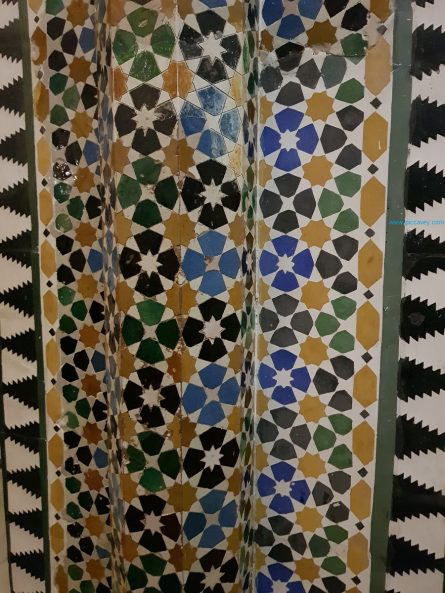
Tile Colours
Despite the decorations being created in the 10th, 11th and 12th centuries. The artisans were cleverly using colour to decorate their ceramics and designs. Colour for architectural elements came from natural sources and were created with these materials:
- Blue – Cobalt
- Purple or Black -Manganese
- Green – Iron
- Red or Green- Copper
- White – Tin
- Yellow – Lead or Antimony
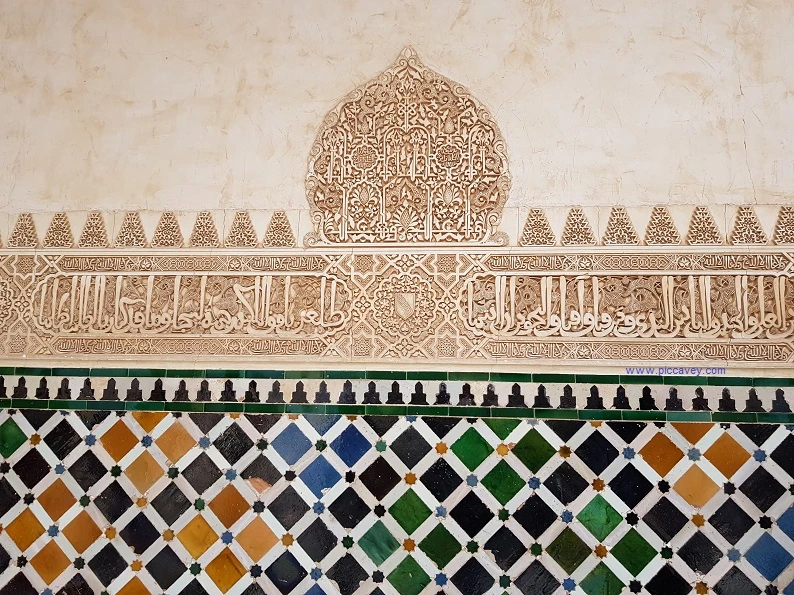
Tile Design in the Alhambra Palace
Above the tiles, higher up towards the walls geometrical shapes or poetic inscriptions abound. Towards the top of the walls quotations from the Koran appear, intentionally situated far from the ground. The higher up the closer to the heavens and the more sacred they should be.
Water and geometry are the main design elements in the Alhambra. Islamic culture does not accept the depiction of human images. Because of this the Alhambra walls have calligraphy, plant motifs and geometric patterns.
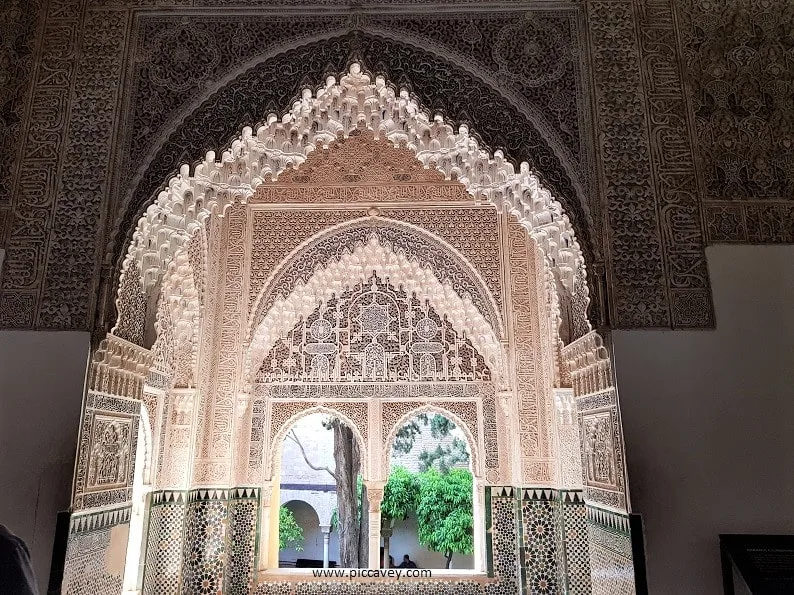
Cuarto Dorado, Alhambra Granada
The façade of the Cuarto Dorado has impressive decoration. The walls are golden in a delicate filigree pattern. The detailed shapes are floral and geometric forms. Due to this extensive detail and the geometry of the Alhambra even mathematicians have analysed the Alhambra.
They see the Golden Ratio in parts of the Alhambra´s design. Despite the ornate appearance of these walls, it doesn´t appear to be a main entrance. This leads to the throne room and into heart of the palace itself.
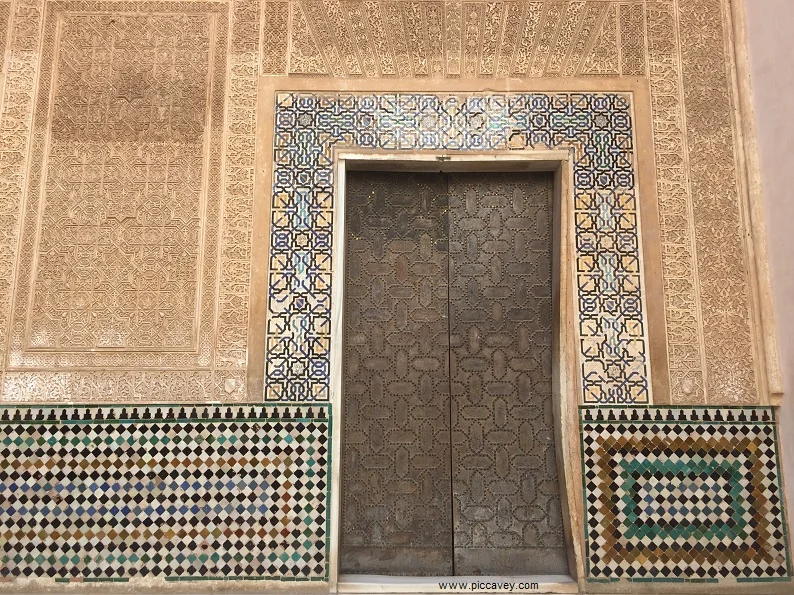
Although the inscriptions above the door give us a clue.
One of them tells us ¨at which the paths split¨
Another clue is the throne verse from the Koran which appears here;
¨His Throne doth extend over the heavens and the earth,
and He feeleth no fatigue in guarding and preserving them
for He is the Most High, the Supreme (in glory).¨
The Throne Room
The design of this throne room is based of many square shapes. Consequently Mathematicians and architects appreciate this room due to it´s symmetry and precision. Also known as the Hall of the Ambassadors would have looked quite different that how we see it today. Because the room would have had brightly coloured rugs, beautiful vases and musical instruments around.
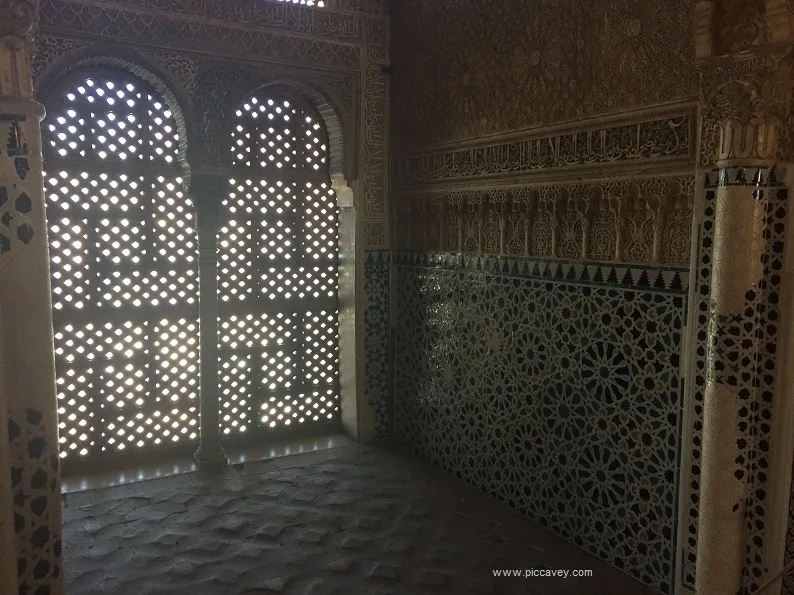
Starry Ceilings
The intricate cedar wood ceiling has exacting measurements. Extremely difficult to put into place it consists of 8017 multicoloured panels. Symbolizing the seven heavens of Islamic Paradise. Diagonal lines radiate from the centre representing the four trees of life. The ceiling in the photo above is decorated with lots of stars. Painted to shine like ivory, mother of pearl and silver. Also worth noticing is the difference between the 8 pointed and 16 pointed stars.
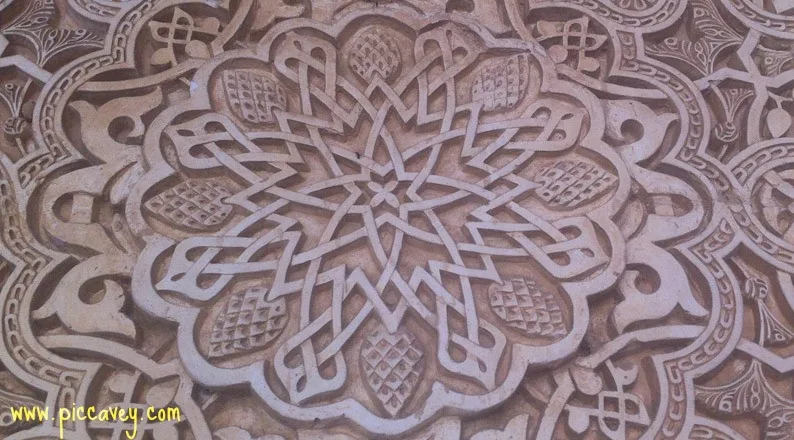
Close up Alhambra Granada
Geometry was a mathematical and intellectual expression. It is also decorative and artist, also practical as these patterns can cover any space.
Most of the room would have been in a dim light, ensuring cooler temperatures. the latticework on the windows allows filtered light into the room. The effect of the light from the windows shone around the throne. This would surround the sultan in diffused light in a dim room creating a position of power and mystery. The throne used to be raised up slightly to give it height.
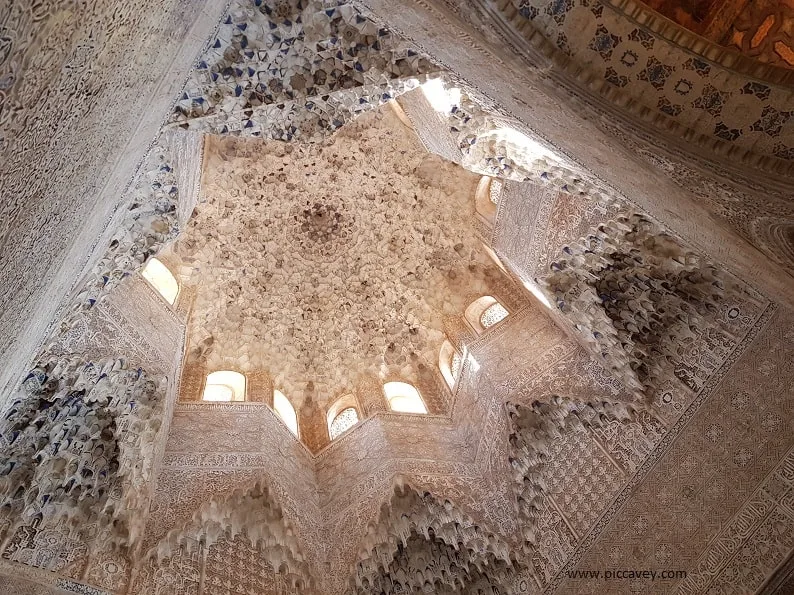
Muqarnas
In the dome above this is a spectacular example of muqarnas. A 3d geometrical shape that began to appear in the mid 10th century in Islamic architecture. Creating a dazzling effect, this is especially used to cover spaces where the levels change.
When we look at the dome we have no idea how high it is or really how big it is as we are mesmerized by so many tessellating shapes and forms. This example in the Hall of the Abencerrajes in the Alhambra is probably one of the best places to see muqarnas.

The Hall of the Two Sisters
Another way to decorate a room was to write poems specifically for the space. Probably by the court poet Ibn Zamrak, (1333-1393). The hall of the two sisters is one of those, it´s verse wrapped around the impressive walls. This room off the Courtyard of the Lions has two huge marble flagstones on the floor. They have the same dimensions on either side of the entrance.
This marble is from the town of Macael in Almeria. I´m sure that it was quite an ordeal moving these huge flagstones almost 200 kilometres in those days. The ceiling in this room is breath taking. Inside the white plasterwork creates a dramatic effect. These shapes are muqarnas . The Alhambra is the best example of Islam architecture in Europe.
Seems like it took many months and years of work to decorate the palace interiors.
The poem mentions this impressive architecture;
The portico is so beautiful that the palace
competes in beauty with the sky.
You dressed it with such an exquisite lamé,
that the loom of the Yemen is forgotten.
¡How many arches are high on its summit,
on the columns that are adorned by the light,
like spheres that turn
above the glowing pillar of the dawn!
The columns are so beautiful in every way,
that their success flies from mouth to ear:
the marble throws its clear light, which invades
the black corner that blackens the shadow;
its highlights iridescent, and one would say that
they are, in spite of their size, pearls.
El Peinador de la Reina
(This space is not open for public visits.) I wanted to include this room as its a complete contrast to the other walls in the Alhambra. Built in 1537 for the Queen Isabel after the conquest of the Alhambra Granada. Originally this was the Tower of Abu I Hayyay. This room is set high up in the tower and has spectacular views over the river and the Albayzin.
With an open balcony, opposite the Carrera del Darro, was a favourite spot for the Catholic Queen. She enjoyed hearing the voices of the people in the town below. Because they would be speaking Mozarabe language….
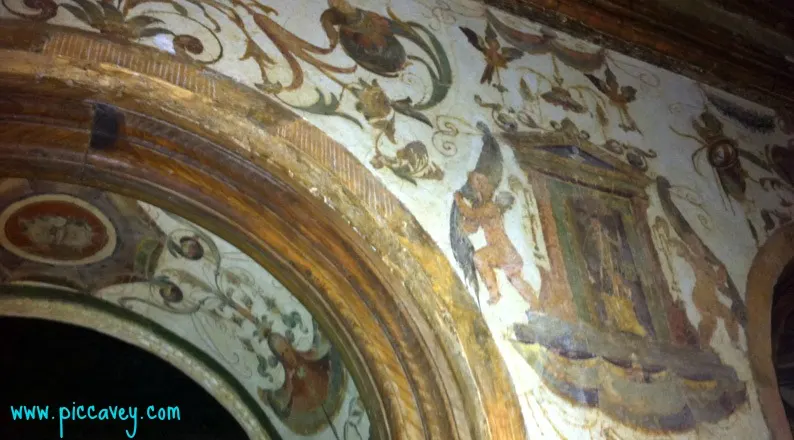
Italian Frescoes
The wall painting are Italian style with rich colours. The frescos by Julio Aquiles and Alexander Mayner are of historical interest. They depict the expedition of Charles V to Tunisia in 1535. Scenes show the army´s departure from the port of Gagiliari, their withdrawal and their return to Sicily.
Other paintings include flowers, animals, angels and other decorative motifs. All set on a white or red background. The space is full of wall paintings leaving no area undecorated. Unfortunately the Catholic Queen never got to enjoy this space as we see it today as these frescos were painted between 1539-1546, Queen Isabel died in 1504.
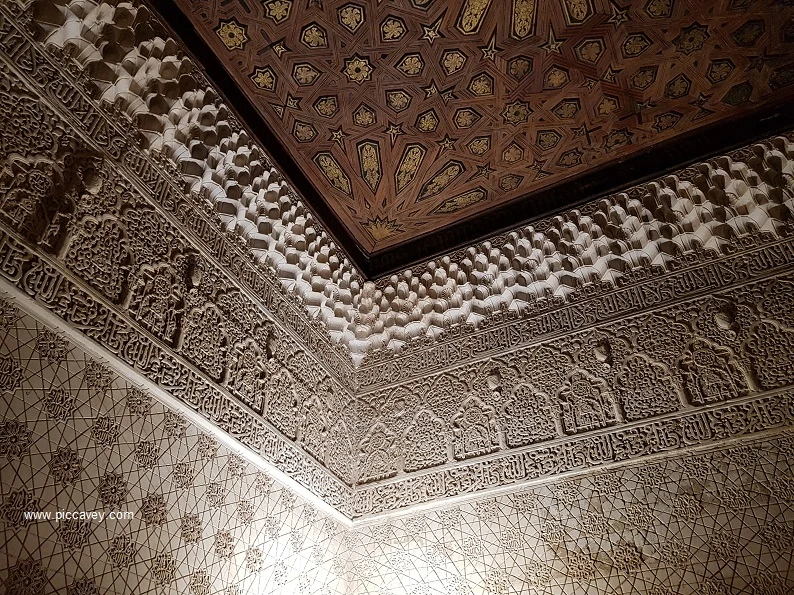
Silks inside the Alhambra
Also in the Alhambra silk was used extensively. They used only the best quality materials for covering walls, cushions and curtains. The silks would have been sumptuous colours and with intricate patterned designs. This decorative element is one which we can no longer appreciate today.
Certainly as this was the throne room, inscriptions here are more abundant:
¨From me you are welcomed morning and evening
by the tongues of blessing, prosperity, happiness and friendship¨
¨has decorated me with the robes of his glory and excellence
without disguise and has made me the throne of his empire
may its eminence be upheld by the master of divine glory and the celestial throne¨

Alhambra Inscriptions
Seems like there are infinite an of inscriptions in the Alhambra. So this is just a small compilation to give an idea of the detail along the palace walls.
You really need to see this in person to appreciate how many there are. Plan ahead and book your tickets for a Alhambra Palace Guided Tour
Other posts in this series are
Travel Resources to Plan Your Visit
Here are a few resources to help you plan your visit to Granada:
-
- Find the perfect hotel or apartment on Booking.com
- Get the perfect Hire Car deal.
- Plan your trip to with these Guide Books
- Find out more from Local guides and Experiences.
- Don´t forget to arrange your Travel Insurance cover
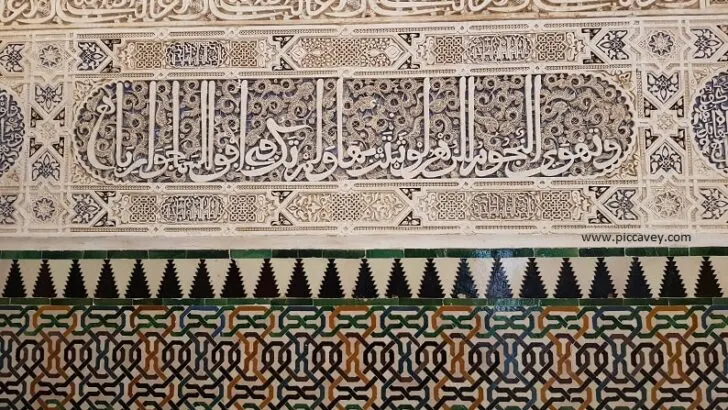
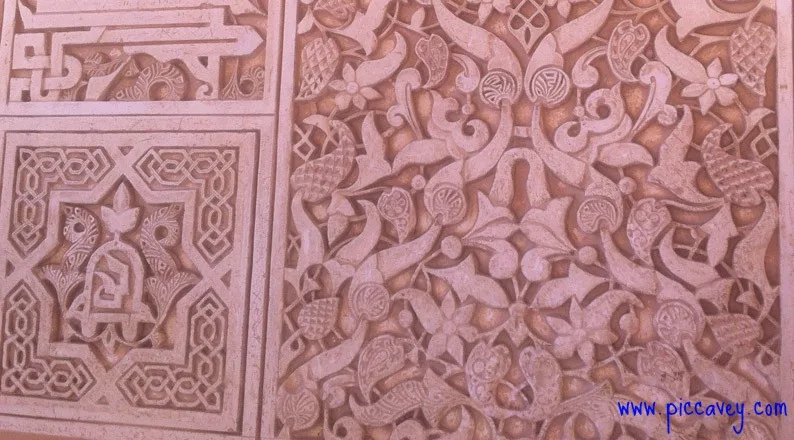
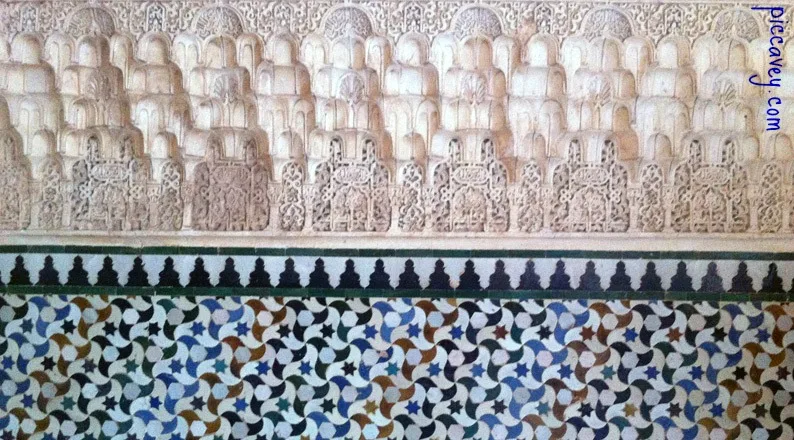
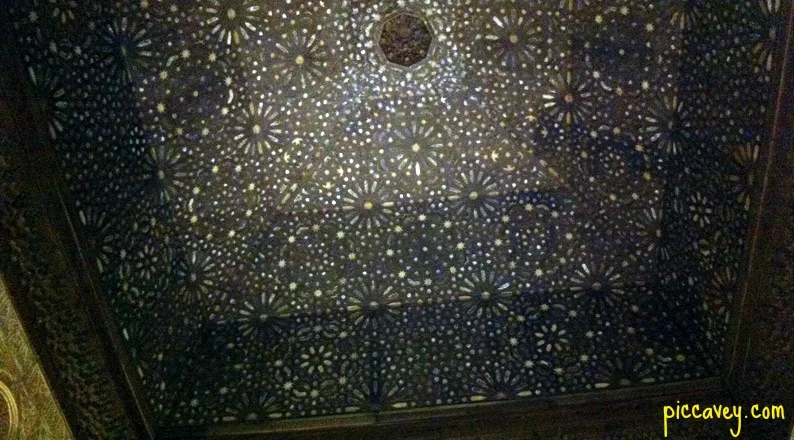
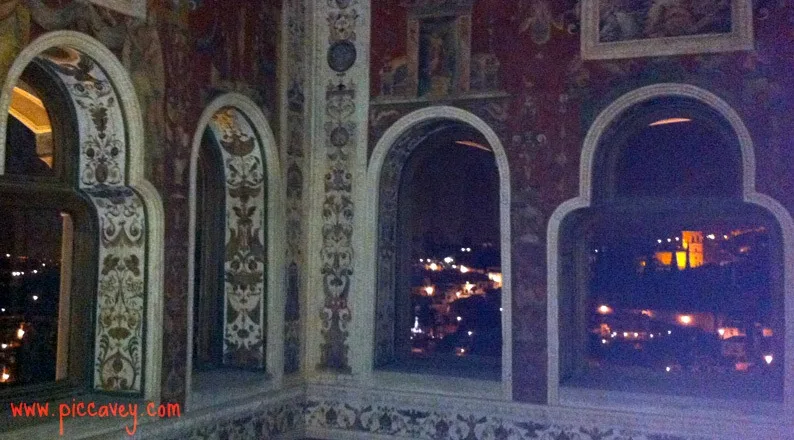

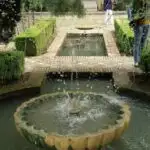
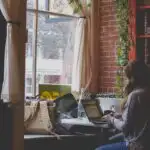


A very interesting article on the Islamic writings on the walls of the Alhambra in Granada. I am very interested in the writings on the Walls of the Alhambra.I have a very good guide book on the Alhambra which I was lucky to win in a draw some years ago run by the Association of the Alhambra together with other books associated with the mentioned. IT is the Official Guide to the Alhambra and it contains sections on the writings on the walls of the Alhambra the translations of the writings etc. It is a very good book a bit on the heavy side to carry around in the Alhambra which is a pity.
,
Yes the topic is actually quite dense as there are so many spaces and years of craftmanship gone into the inscriptions. Way to much to cover in one single article of course.
This is great! I have visited La Alhambra with my father, very special trip. Question, the second photo from the top under your words “Another thing that these walls offer are clues into the functionality of different spaces around the monument.” Where in La Alhambra is this located and do you know anything about the pattern on the left in that photo? (Square tile with 8 pointed star). Thanks so much, very enjoyable reading!
The geometrical patterns and shapes used in the Alhambra were often chosen so that they could cover large spaces of palace walls and continue. possilby in Islam they used the eight pointed star as a symbol of life. The octagram or 8-point star is a symbol of fullness + regeneration.
Thank you!
I Love the Alhambra Palace very much and i have the official Guide Book to the Alhambra Palace which i was lucky to win in a draw together with other books on Granada etc. Run by the Alhambra it has many coloured photos of the Alhambra and the Generalife and lists of the Caliphates of the Alhambra and Granada.
It is a very good Guide book worth reading but a bit heavy to carry around all day
Thanks for this Molly it’s fascinating. I have visited the Alhambra but didn’t appreciate some of the reasoning behind the detail in the palaces. My sister and two of my amazing nieces visited the Alhambra recently and would like to go back again . I will forward your blog to them .
Glad you enjoyed finding out more, I have visited the Alhambra several times each year since living here 12 years and still havent discovered it all.
1000 years of history is a lot to appreciate
[…] Some inscriptions are beautiful poetry whereas others provide information on construction dates of building within the Alhambra. These writings also give us clues into the functionality of different spaces around the palaces. Retrieved from https://www.piccavey.com/granada-alhambra-walls/ […]
Thanks, Molly! I will be in Granada in a week and all excited. Incidentally, Islamic civilization had huge influence half the world across – in the Mughal architecture and art in north India. It also influenced the south Indian state of Hyderabad via Persia.
Thanks for those interesting details. This architectural style is stunning. Enjoy your visit to Granada, Springtime here is just beautiful
Wonderful post, Molly. The Alhambra palace, grounds and the entire city of Granada has a rich, diverse and fascinating history. I can’t wait to get back and continue exploring!
Yes, there is just so much to discover in Granada and Andalusia
Is Granada something that 3 days can be spent in? I was planning a Seville trip with a day to Cordoba but that’s been stopped so I’m looking for a great alternative. Thank you!
Yes, of course.
This weekend plan may help you organise your visit.
https://www.piccavey.com/granada-weekend-spain/
Alhambra palace is always full of mysteries and connections with different cultures, religions and with a mixture with astrology and science. Thanks for sharing.
I love the Moorish architecture of Andalucia, and this post made me realise all the details I missed in the Alhambra. My focus was very much on the graphic designs, tiles, water features; I find it fascinating to read an alternative perspective focused on the meaning of the texts. Thank you, this is a comprehensive and educational post.
Thanks Julie!
I have lots count of the times that I visited the Alhambra, there is so much to take in
For me each time I visit I learn something new.
Very interesting, Molly and has me planning when I could possibly make my next trip to Granada. Some of the poetry even in translation is beautiful and matches my memories of the Generalife.
thanks for reading!